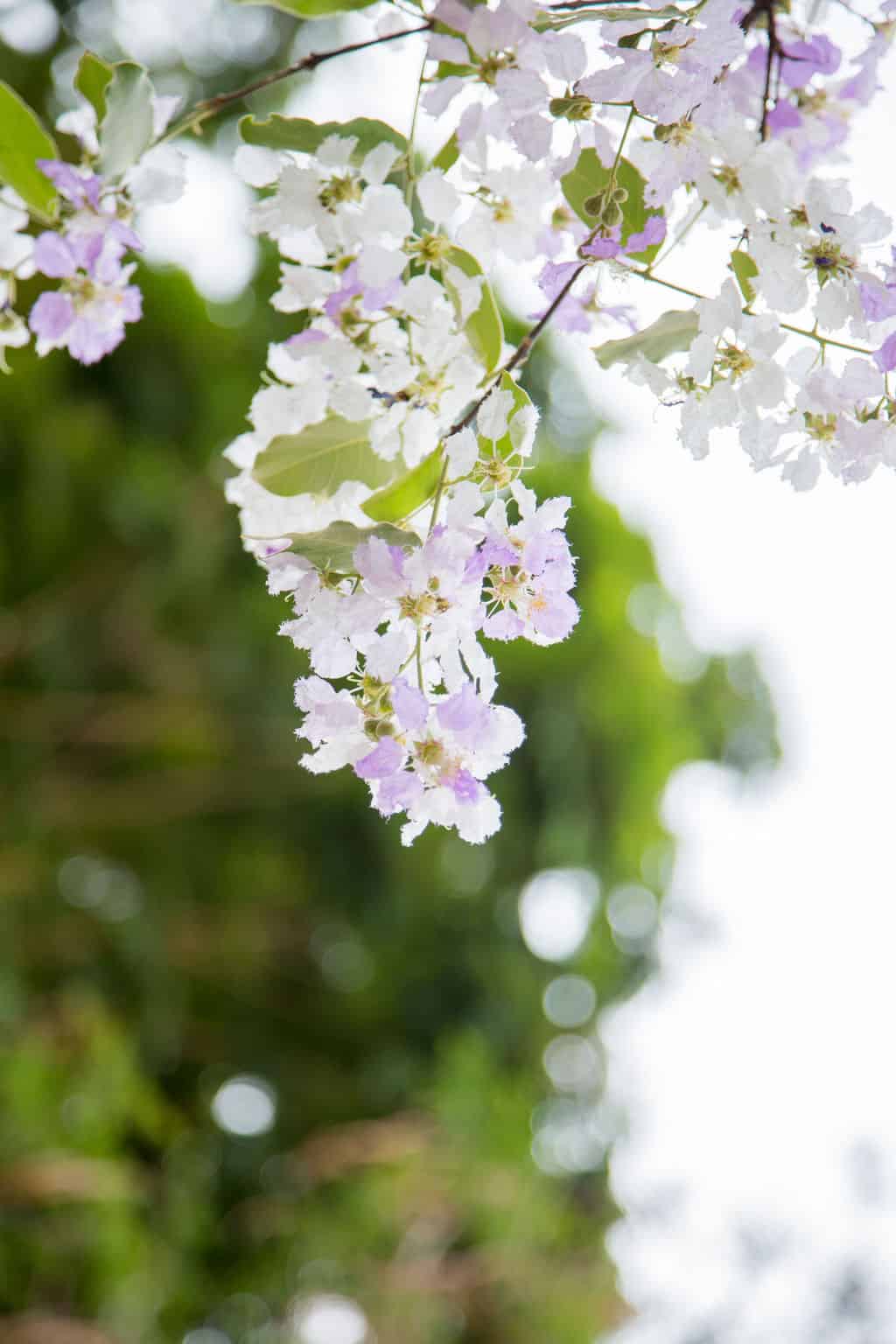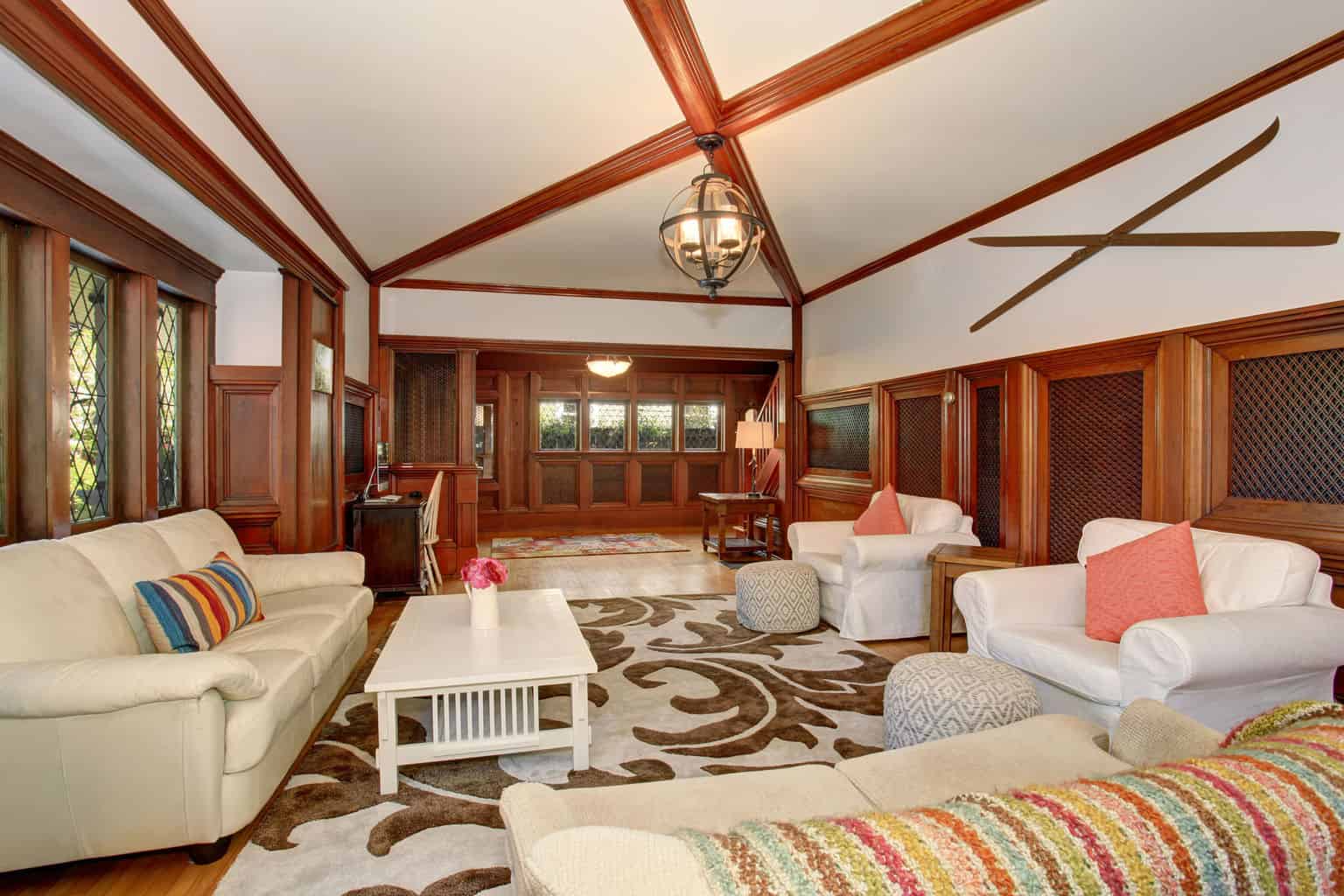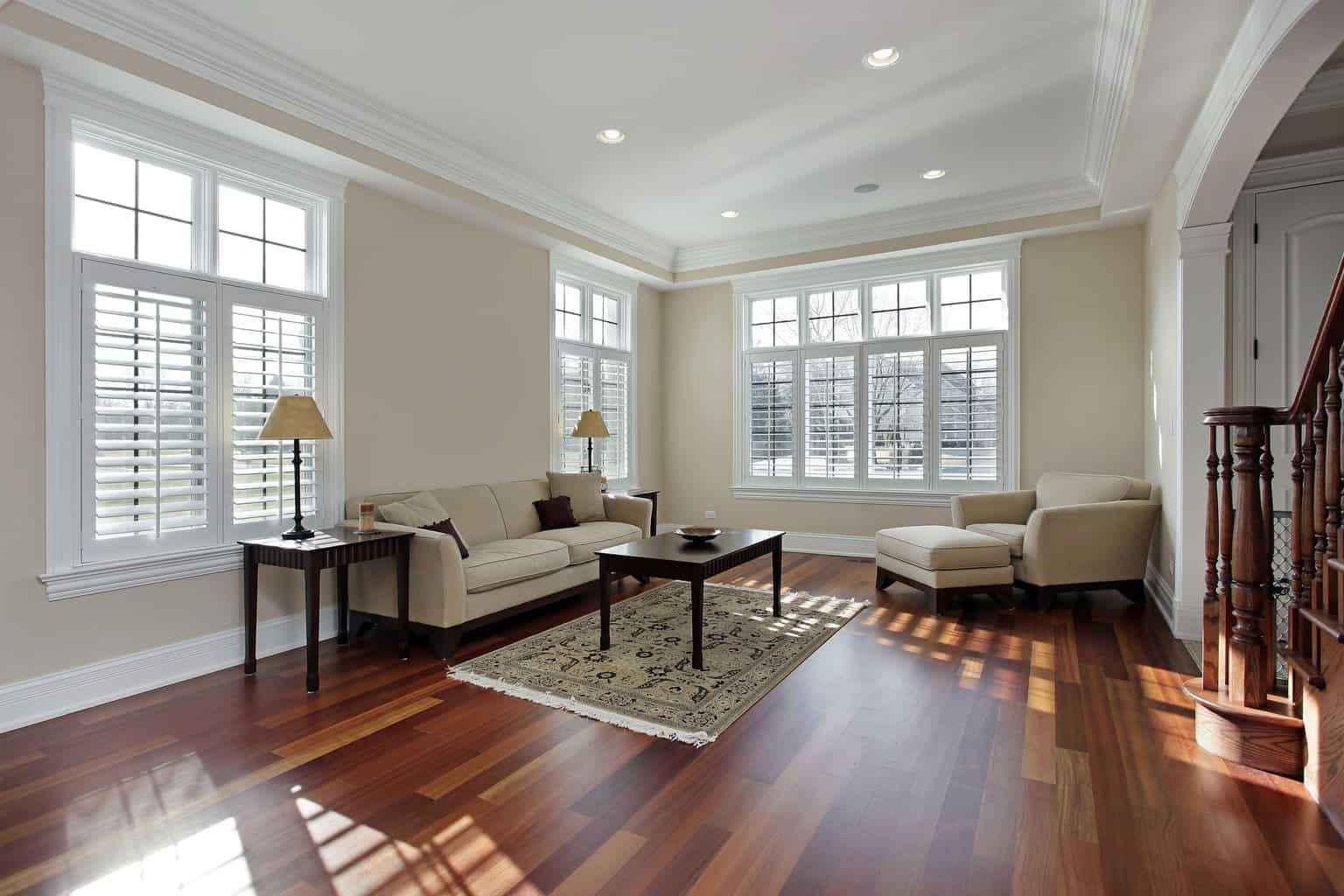Perhaps the first thing people think about when they hear “cherry tree” is the old parable regarding a young George Washington chopping down his father’s tree. In addition to having lovely blossoms and making a gorgeous landscaping statement, cherry wood is a great material for hardwood flooring because of its rich and distinctive coloring.
Cherry wood’s color varies from a rich red to a reddish brown and its color darkens with age due to oxidation. When used for flooring cherry provides you with a satiny, smooth texture that adds warmth and character to any home. The wood from cherry trees, prunes species, a subset of the rose family, has been used in furniture making since 400 BC.

Advantages and Disadvantages of Cherry Wood Flooring
Some of the advantages of using cherry for your home’s flooring are:
- Produces an excellent and smooth finish
- Is readily available as an unfinished or prefinished flooring material
- Is easy both to clean and to maintain
However, as with all wood flooring, cherry flooring has its disadvantages too and these include:
- Fading
- Easily scratched by dirt and grit
- Damaged by excess moisture

How Can You Tell If This Is The Floor For You?
There are five questions you should investigate if you are considering selecting cherry hardwood flooring for your home:
- What kind of cherry wood do I want to use for my flooring?
- Will cherry hardwood accentuate or distract from the style of my home?
- Is cherry going to be a durable enough flooring option for me?
- How much can I expect to pay for a cherry hardwood flooring?
- From where should I purchase cherry hardwood flooring?
What Kind of Cherry Wood Do I Want to Use For My Flooring?
The answer here is really going to depend on what style you are looking for, the overall look you want to achieve, in what kind of room you plan to install the cherry flooring, and your budget. Cherry trees are grown worldwide, although not all are used for flooring material. Brazilian cherry is by far the most popular cherry hardwood flooring used, but the Asian and Bolivian cherry varieties can also be used. Cherry hardwood planks are easy to machine, glue and nail well and so are easy to install, and result with a smooth finish when sanded. Cherry wood also dries quite quickly after milling, but has a high shrinkage rate unless it has been kiln dried.

Each species of cherry hardwood flooring has a different Janka rating. The Janka hardness rating is the measure of hardness for all wood varieties used for flooring. The American Cherry hardwood has the lowest score of the cherry wood varieties, with a rating of only 950. The Janka rating of other cherry woods is Brazilian cherry – 2820, African cherry – 1010, and Bolivian cherry – 3190. Lumber liquidators has a helpful chart that can be found here that will show you a comparison of the Janka ratings of many different hardwood varieties.
Cherry flooring has been used for many decades in the construction industry. The flowering version of the tree that has been made famous by Washington D.C.’s Cherry Blossom Festival was introduced to America in 1900 as a gift from Japan. American cherry wood is softer than all of the other cherry woods, so it is not as popularly used for flooring as it is in landscaping. Brazilian or Jatoba cherry is an imported exotic hardwood and is the much more popular flooring choice.
Will Cherry Wood Accentuate or Distract From the Style of My House?
Selecting the right wood, possibly Brazilian or Bolivian hardwood cherry flooring, you will enjoy its unique grain and deep color for years to come. I personally love the look of cherry wood flooring, as it is noticeable, makes a statement, and unique in appearance, but will not draw the focus or overwhelm the other features of a room. It pairs well with almost any décor style and gives off a homey feeling that isn’t lacking in luster.

Cherry hardwood floors have an excellent smooth finish that is durable and adds warmth to any room. Brazilian cherry hardwood flooring has an open-grained appearance similar to that of oak but is twice as hard. An interesting feature of cherry hardwood flooring is the dark brown or black streaks that contrast with its background, ranging from dark orange to reddish brown. It is important to note, however, that Brazilian cherry hardwood flooring darkens after several months, so this should be taken into account when considering using it for flooring. Cherry hardwood flooring is readily available and is one of the most commonly used hardwoods in America.
Is Cherry Going to be a Durable Enough Flooring For Me?
Select your cherry flooring carefully because some cherry woods are significantly softer than others. As with other wood floors, cherry has the advantage of being easy to clean and maintain. When choosing a cherry wood flooring, most lean towards the Brazilian variety that is significantly stronger and has a measure of hardness rating that is significantly higher than many other hardwood flooring varieties, including pine and oak. You will need to seal or wax a cherry wood floor, and as with any type of hardwood flooring, that will need to be re-done occasionally, according to the manufacturer’s instructions. Brazilian cherry hardwood flooring is available in pre-finished or unfinished, and in thicknesses ranging from 3/8″ to 3/4”.
Unlike carpeting, hardwood flooring does not collect dust readily, so a dust mop is ideal for daily cleaning and damp mopping your cherry floor will remove dirt and grime. Wet mopping of wooden floors is not advisable and can lead to warping. Always ensure that you use a damp mop and your cherry hardwood floors will retain their shine, luster, and appeal.

By not taking care of your cherry flooring you will see a loss of shine and luster. When exposed to strong, direct sunlight tends to bleach out, losing its coloring. Filtering the light through a window film or window coverings can help to prevent this. Dirt and grit can act like sandpaper, scratching the finish and eventually the wood. Placing rugs and mats at doorways helps reduce this problem. Spills can damage the finish and even warp the wood, if not wiped up quickly. Because of wood’s natural tendency to absorb moisture, it is often recommended to avoid placing cherry flooring in kitchens, bathrooms, or laundry areas.
Bolivian cherry hardwood flooring can have provide some challenges. When sanding this wood, the dust can cause allergic reactions, such as contact dermatitis and respiratory allergies. Oil finishes do not dry properly, making water-based finishes a better choice.
How Much Can I Expect to Pay for a Cherry Hardwood Flooring?
Cherry wood is comparable in price per square footage to most other hardwoods. You can expect to pay about $2-$5 per square foot when purchasing cherry hardwood flooring planks, and installation costs are typically about the same as with any other hardwood flooring. With installation, you may expect to see costs of around $4-$8 per square foot for cherry hardwood floors. Because it is grown and harvested locally, American cherry wood is significantly less expensive than the more common (and stronger) Brazilian cherry wood, which comes from the jatoba tree native to the jungles of the Amazon.

There are, of course, less expensive options to achieve the look of cherry hardwood floors without paying for the solid hardwood planks. There are laminate flooring options comprised of cherry hardwood layered over a wood composite, or even vinyl or tile options designed to mimic the look of a natural cherry hardwood floor.
From Where Should I Purchase Cherry Hardwood Flooring?
I get asked this question a lot. People are always coming to me looking for reputable providers of certain varieties of hardwoods and my answer does really vary depending on the particular hardwood species you are looking for and whether you are sold on purchasing a solid hardwood flooring or are considering other options, such as a laminate flooring designed to look like a cherry hard wood. When purchasing a Brazilian cherry hardwood flooring, it is important to purchase from someone reputable who uses sustainable practices, as the jatoba tree is one of many that have been over-harvested, contributing to the deforestation of the Amazon. You can check with Forestry Stewardship Council on sustainable practices and do research before purchasing any hardwood flooring. Typically, my advice is that if a price seems too good to be true, it usually is. Do market comparisons and get feedback and reviews before making any kind of major home purchase, including flooring.

When considering flooring options for your home or office, cherry hardwood flooring makes for an interesting and dramatic choice. Not only will cherry hardwoods add warmth and elegance to a room, but will also increase the resale value. Since you can readily buy cherry hardwood floors from any hardwood specialty stores, you won’t have trouble finding a quality, beautiful flooring that fits your tastes. You also won’t have to resort to chopping your own cherry tree, like George Washington!

I noticed that since using vinegar and water on my Brazillian hardwood floors that were installed in March 2008 footprints were noticeable on my floors. I found this on the following website, but have not tried it yet. Has anyone out there tried windex on their Brazillian Hardwood?
http://www.brazilianhardwood.com/tools/cleaning.html
Personally I don’t use Windex for anything — I hate the smell. Are you making your vinegar solution at the right dilution? Are you buffing your floor after damp mopping it?
When I had too strong a vinegar solution and didn’t buff my floors afterward I too had the problem you are describing. I don’t any more; I weakened my solution (15:1 water:vinegar) and do a quick buff and have beautiful floors.
We recently purchased a house with a 2 year old Brazilian Redwood back porch. It has been exposed to some weather and is grey. What can we do to renew the wood?
Hi Lisa,
You can try power-washing your deck, or better yet, sand it. After it dries, stain it. Ask around at your local hardware or home improvement store – they’ll be able to steer you to the right products.
I did run across something that sounds good – Messmers Wood and Deck Cleaners/Brighteners- Messmer’s Wood and Deck Cleaner and Brightener (Part A and B) powder concentrates are specially formulated to clean and brighten exterior wood decks, fences, log homes, and other exterior wood projects.
And they also have Messmers UV Plus for Hardwoods and IPE
Messmer’s UV Plus for Hardwood Decks is a premium natural wood finish which protects and beautifies exterior wood decks and other wood projects. For dense exotic hardwoods like Ipe, Mahogany, Brazilian Redwood, Massaranduba, Meranti, Pau Lupe, and Teak
I can’t vouch for the products personally, but I’ve been reading some good things that others have said.
Lisa, I found StainSolver on this site and have used it for just this project. I washed the deck with a solution of Stain Solver and scrubbed it with a brush. Then I rinsed and redid areas that weren’t as clean as I wanted. When I had it finished I let it dry thoroughly before sealing it. I personally like the look of natural wood so didn’t stain it, but my neighbors stained their deck as they sealed it. The deck looks great!
Thank you for your input! Yes, I too think that StainSolver is a wonderful product, and have recommended many times. Lisa, you may want to try this product first as it’s environmentally friendly as well as *just* being a product that usually does very well for this type of job.
After you clean floors with vinegar and water some articles mention to follow up with a final follow up polish. What type of polish should I use on the cherry hardwood.
Hi Bill,
I think that what you’re referring to is when it is meant to use a dry microfiber mop to ‘polish’ the floor, sort of like a light buffing……. to shine it up a bit.
You’re floor shouldn’t need a real polish after cleaning – unless it’s at the point to where it really does! You don’t have to apply polish every time you mop – that’d be a real pain if you mop your floors once or twice a week! ;~)
My brazilian cherry floor has darkened quite a bit since I installed it 4 months ago. It is considerably lighter where there where carpets and furniture placed. Seems to be the oposite from your comments above. Do you have any advice for me?
Thank you very much for your info.
It does darken, but sometimes it will actually lighten (after the initial darkening) in very strong sunlight, especially outside. The best thing to do would be to rearrange your furniture and throw rugs for a while to help it darken evenly – hopefully that’s a possibility for you.
I am considering buying Sakura cherry engineered wood floors for my apartment. Do you have any experience with this? How does it wear compared to, say, maple or oak? Any insight would be very appreciated.
Hi Elaine,
I would think that they’ll pretty well wear the same.
Different products have different warranties, don’t skimp – buy something that’s going to last. Remember, the top layer can come in different thicknesses too, which is handy to know in case you figure you’ll be having to refinish the floors at some point in your life. ;o)
I have a Brazilian Teakwood floor. It had several layers of “instant” shine wax applied. I am trying to restore and have been unsuccessful in removing the wax. Any suggestions?
Hi Jeaneen,
Do you know what type/brand of ‘instant shine’ finish was applied?
I believe it was two–Oranage Glo and Quick Shine. Thanks!
What have you used to try to remove it?
If you do some google-ing, you’ll find that Orange Glo wax & Quick Shine have many complaints from users.
I’ve read this process works for removing Orange Glo: Use Windex to remove the waxy residue. First, clean your floor in SMALL sections. This is very important because you want to evenly remove the wax. Second, use fresh unused paper towels with each new SMALL section. You are removing wax which will transfer onto your paper towel. Do not take shortcuts (i.e. use dish towel) or be cheap (re-use paper towels) as this will cause you more grief later. Will this remove all of the Orange Glo wax? Your guess is as good as mine………
From what I gather, it’s a real pain to remove Quick Shine. You can either throw some elbow-grease into the floor and mop with really hot water at least 4 times over the area you want to come up, OR you can dry buff the floor. Either one of those work (dry-buffing will work faster). Really, I wouldn’t recommend the hot water on wood floors, just a bad idea. Other than that, you may actually need to sand the floor to get rid of it, and then use some good products for sealing your floor. I would recommend Diamond Coat Varathane Polyurethane – I’ve always gotten great results with their products.
Now…….what to do for YOUR floor now that we’ve found something that removes both of the products…. I’m not wild about Windex in general, though they do have an environmentally friendly line out now, uses vinegar. It may work to use a simple solution of vinegar/water – I recommend a 1:15 ratio for cleaning floors, this may require using a bit less water since you want to get this gunk off your floor. I would use a fine abrasive pad, I’d really be afraid to use anything very rough just in case you do get through the layers of this stuff and wind up abrading the wood to where you really have refinish it. Try it in a small and hopefully out-of-view area – even I don’t know if this will really work. I’d also recommend using your favorite search engine (mine’s Google) and doing further research to help draw your own conclusions – you might find something even more helpful & practical than what I’ve found.
What would I do? I’d bite the bullet and hire a professional to strip the floor, including sanding to prep for refinishing. You could either have them refinish it or refinish it myself.
I have American Cherry floors and they have also darkened as Colleen’s did. When I called my installer he also recommended moving my rug but it has been a few months and I can still see a distinct difference. Do you have any other suggestions?
Hi Brandi,
It’s still going to take some more – a few months isn’t enough. Don’t worry – it’ll get there in it’s own good time. ;~)
Hi,
We have a house full of Brazilian Cherry floors… just beautiful! In many areas, they are in need of sanding and refinish. Since this requires our leaving the house for up to a week, I am wondering how I can protect them and make them look nice in the meantime. Any suggestions?
Thank you.
Kathy
Hi Elaine,
I have 2 new brazilian cherry tabletops in my kitchen … one over the wetbar area and a 2nd, round “cafe” type table at the end of my kitchen peninsula. Both are newly installed and they are THICK wood. How would you recommend that I care for the brazilian cherry counters? Already I see a slight need to treat with a polish / conditioner / oil to bring back the original luster after a newly-renovated kitchen and a fair amount of dust and debris flying around. Thanks!